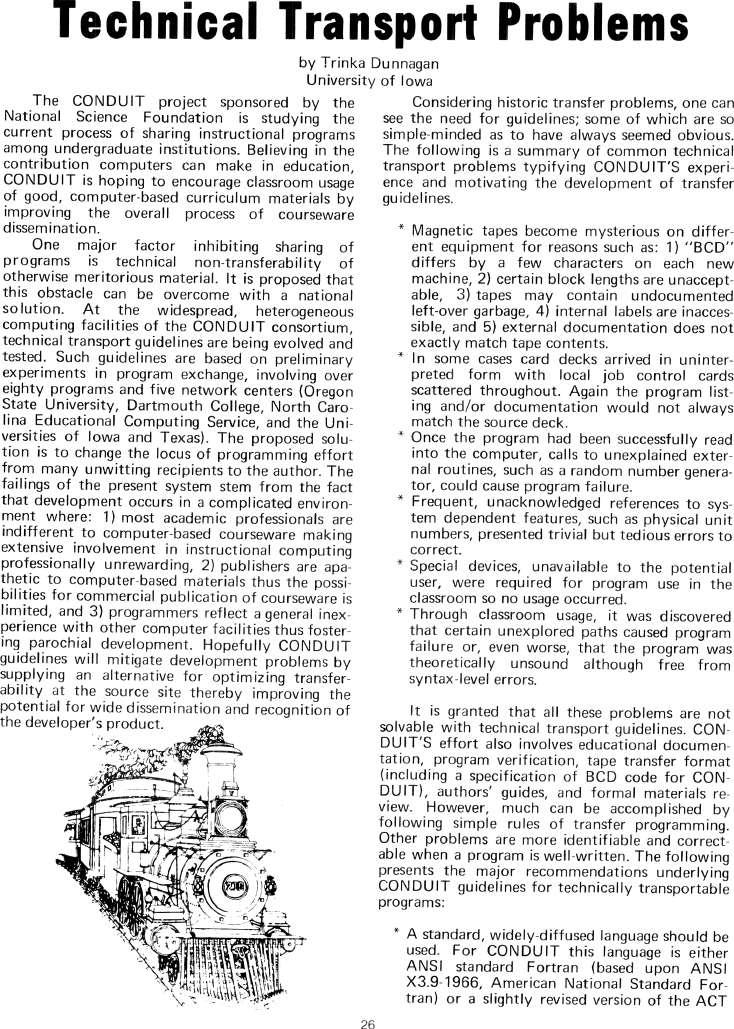The Best of Creative Computing Volume 1 (published 1976)
Technical Transport Problems (CONDUIT Project studies the process of sharing instructional programs among undergraduate institutions)

Technical Transport Problems
by Trinka Dunnagan
University of Iowa
The CONDUIT project sponsored by the
National Science Foundation is studying the
current process of sharing instructional programs
among undergraduate institutions. Believing in the
contribution computers can make in education,
CONDUIT is hoping to encourage classroom usage
of good, computer-based curriculum materials by
improving the overall process of courseware
dissemination.
One major factor inhibiting sharing of
programs is technical non-transferability of
otherwise meritorious material. It is proposed that
this obstacle can be overcome with a national
solution. At the widespread, heterogeneous
computing facilities of the CONDUIT consortium,
technical transport guidelines are being evolved and
tested. Such guidelines are based on preliminary
experiments in program exchange, involving over
eighty programs and five network centers (Oregon
State University, Dartmouth College, North Carolina Educational
Computing Service, and the Universities of Iowa and Texas). The proposed
solution is to change the locus of programming effort
from many unwitting recipients to the author. The
failings of the present system stem from the fact
that development occurs in a complicated environment where: 1) most academic
professionals are
indifferent to computer-based courseware making
extensive involvement in instructional computing
professionally unrewarding, 2) publishers are apathetic to computer-based
materials thus the possibilities for commercial publication of courseware is
limited, and 3) programmers reflect a general inexperience with other computer
facilities thus fostering parochial development. Hopefully CONDUIT
guidelines will mitigate development problems by
supplying an alternative for optimizing transferability at the source site
thereby improving the
potential for wide dissemination and recognition of
the developer's product.
Considering historic transfer problems, one can
see the need for guidelines; some of which are so
simple-minded as to have always seemed obvious.
The following is a summary of common technical
transport problems typifying CONDUlT'S experience and motivating the development
of transfer
guidelines.
* Magnetic tapes become mysterious on different equipment for reasons such as:
1) "BCD" differs by a few characters on each new
machine, 2) certain block lengths are unacceptable, 3) tapes may contain
undocumented left-over garbage, 4) internal labels are inaccessible, and 5)
external documentation does not exactly match tape contents.
* In some cases card decks arrived in uninterpreted form with local job control
cards
scattered throughout. Again the program listing and/or documentation would not
always match the source deck.
* Once the program had been successfully read
into the computer, calls to unexplained external routines, such as a random
number generator, could cause program failure.
* Frequent, unacknowledged references to system dependent features, such as
physical unit numbers, presented trivial but tedious errors to
correct.
* Special devices, unavailable to the potential
user, were required for program use in the
classroom so no usage occurred.
* Through classroom usage, it was discovered
that certain unexplored paths caused program
failure or, even worse, that the program was
theoretically unsound although free from
syntax-level errors.
It is granted that all these problems are not
solvable with technical transport guidelines. CONDUIT'S effort also involves
educational documentation, program verification, tape transfer format
(including a specification of BCD code for CONDUIT), authors' guides, and formal
materials review. However, much can be accomplished by
following simple rules of transfer programming.
Other problems are more identifiable and correctable when a program is
well-written. The following
presents the major recommendations underlying
CONDUIT guidelines for technically transportable
programs:
* A standard, widely-diffused language should be
used. For CONDUIT this language is either
ANSI standard Fortran (based upon ANSI
X3.9-1966, American National Standard Fortran) or a slightly revised version of
the ACT


